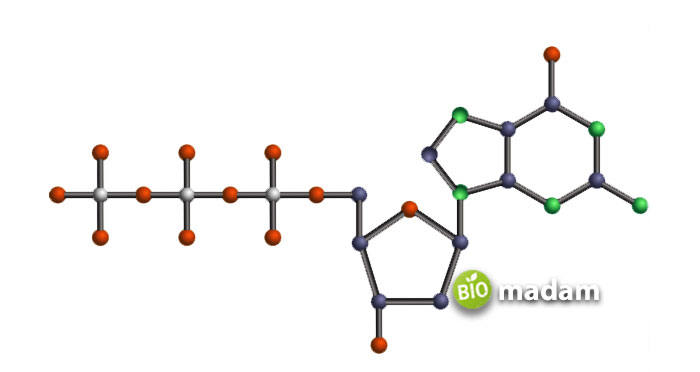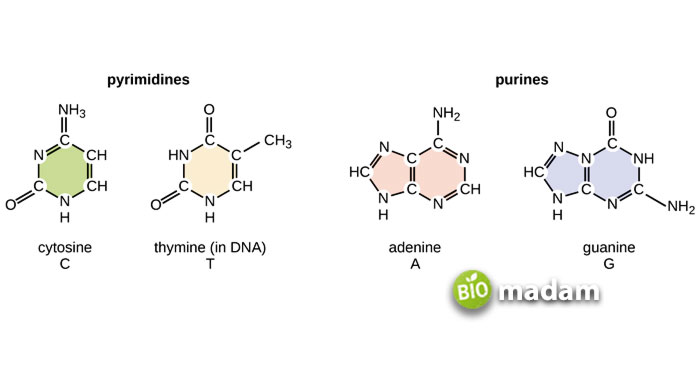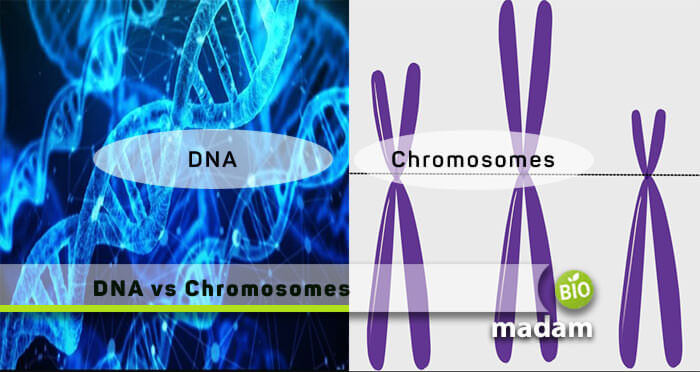All organisms are made of trillions of cells where many living organisms, bacteria, and viruses contain DNA as their inheritable material. Whenever an individual cell divides, the genetic information is copied to the daughter cells that get their distinct characteristics. DNA generally appears to be a double helical structure that combines with specific proteins to shape a chromosome. The main difference between DNA and chromosome lies in their structure and organization. DNA is an unorganized part of the chromosome containing gene information where chromosomes are long, complex strands of DNA and histone protein.
We will review the differences between DNA and chromosome in detail, but before that, let’s grab its comparison table.
Comparison Table
| Basis of Comparison | DNA | Chromosome |
| Definition | A double helical, macromolecule structure, consisting of deoxyribonucleotides. | A loose thread-like structure that is all made up of histone proteins and DNA, arranged in a special sequence. |
| Individual Composition | Entirely made up of deoxyribonucleotides | In Eukaryotes: DNA & Histone ProteinsIn Prokaryotes: Histone Proteins only |
| Structure | Simple structure with double helix strands | The condensed structure having two DNA molecules |
| Function | Consists of all the instructions required for an organism to live and grow | Regulates the genetic information from generation to generation |
| Identification Test | DNA can be separated through Gel Electrophoresis | Chromosome analysis is a test to identify chromosomes. This test is also called Karyotyping |
Explain DNA
A chemical structure used to store genetic information in a living body is called DNA. It is an essential macromolecule that functions for the development and reproduction of a body. DNA is all composed of deoxyribonucleotides that have monomers as subunits. A single nucleotide involves a phosphate group and a nitrogenous base linked to a phosphate sugar. There are four different types of nitrogenous bases seen in DNA, such as cytosine, adenine, guanine, and thymine.

The double-helix structure of DNA has nucleotides attached to the sugar of the opposite nucleotide through phosphodiester bonds. Furthermore, the hydrogen bonds between cytosine/guanine and adenine/thymine connect the polynucleotide strands, supporting the sugar-phosphate backbone.
Each strand of DNA holds the other in such a way that both are equal but opposite in direction (anti-parallel) Also, there is a clear difference seen in the replication of eukaryotes and prokaryotes.
The four essential nitrogenous bases of DNA make it organized to form a chromosome. These strands help in storing genetic information. A human genome consists of 3.2 billion base pairs of DNA.
Explain Chromosome
A chromosome is nothing but the long strands of DNA containing the encoded genes. Besides DNA, the chromosome contains even more chemical components these are either autosomes or sex chromosomes. Each gene on a chromosome comes with a unique sequence having a special location (locus). Chromosomes are entirely made up of DNA and histone proteins for a eukaryotic cell. When these two components initially combine together, they form nucleosomes. These bodies have fiber-like projections called chromatin.
Chromatin is nothing but a present form of DNA within a nucleus. They are thread-like in shape, which further condenses to form a chromosome. Hence, chromatin is a less-condensed structure of a chromosome. A cell usually consists of chromatin bodies that convert to chromosomes only at the time of division.

There is a clear difference between the chromosomes (long DNA strands) of eukaryotic cells and prokaryotic cells. The former includes large, linear-shaped chromosomes while the latter has circular chromosomes tightly bound to histone proteins. A human body has 46 chromosomes, and each one has hundreds and thousands of genes. Proper sequencing of DNA in a chromosome identifies a gene expression. A chromosome has centromeres and telomeres that play a central role during mitosis and meiosis in replication.
Review the Key Differences Between DNA & Chromosome
Definition
DNA
Deoxyribonucleotides are double-helical structures that have nitrogenous bases to store inheritable information.
Chromosome
The most organized structures of DNA together make a chromosome. These are typically condensed in nature.
Composition

DNA
DNA is composed of deoxyribonucleotides having monomer subunits of four bases. These include Adenine (A), Guanine (G), Cytosine (C), and Thymine (T).
Chromosome
When condensed double-helical DNA structures combine with histone proteins, a chromosome is formed.
Key Role
DNA
This chemical unit holds an individual’s genetic information in a cell.
Chromosome
These are the structures taking part in cell division that transfers a cell’s information to its next generation during replication.
Final Verdict
A bit confusing to remember the difference between DNA and chromosome. Just bear in mind that a gene consists of different types of chromosomes that identify the characteristics of a living body. Moreover, all these chromosomes are composed of DNA material and histone proteins tightly packed into each other. All in all, we can say that chromosome is a single storing unit for DNA.

Hello, I would like to introduce myself to you! I am Chelsea Rogers, an experienced blog writer for science articles, holding an MPhil degree. My enthusiasm to grab the best knowledge, let it relate to botany, zoology, or any other science branch. Read my articles & let me wait for your words s in the comment section.

